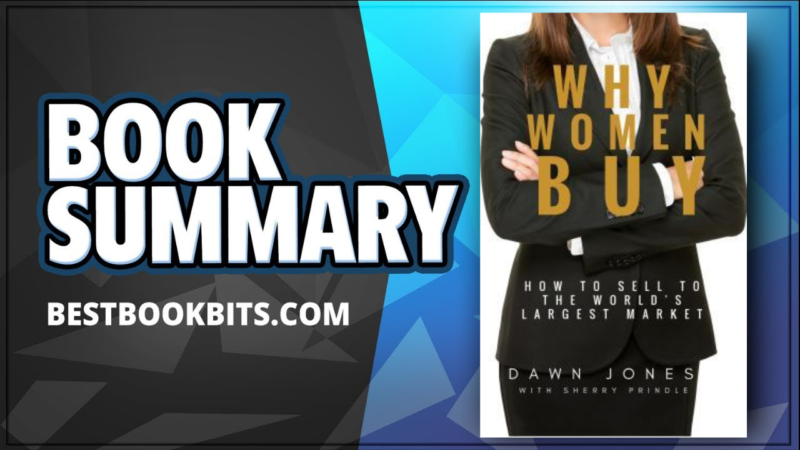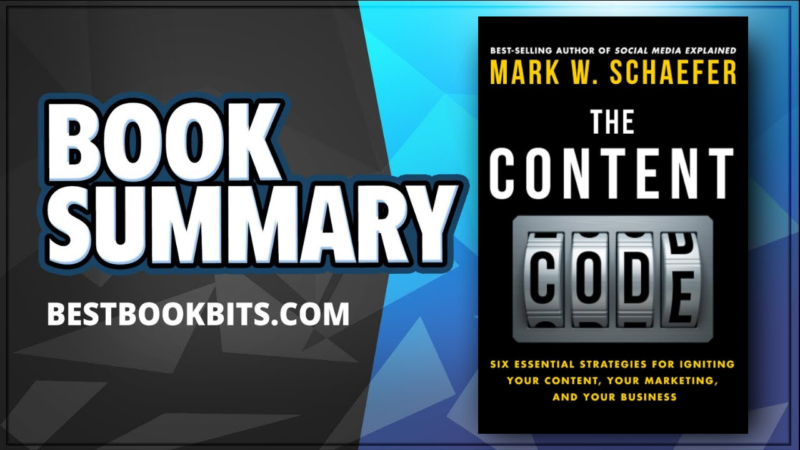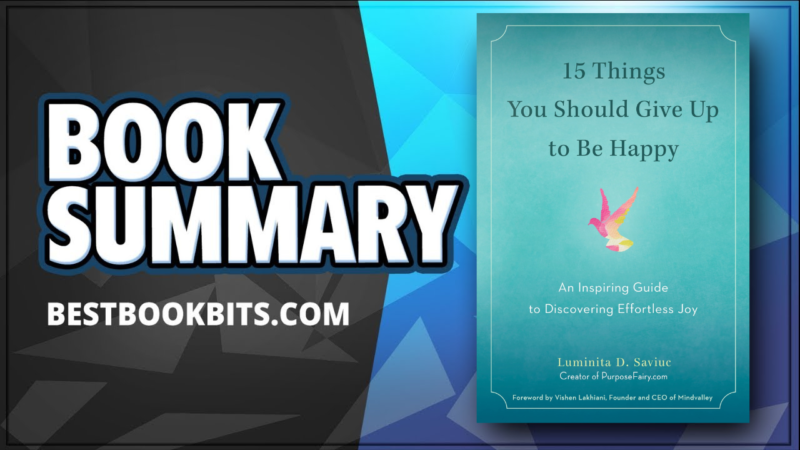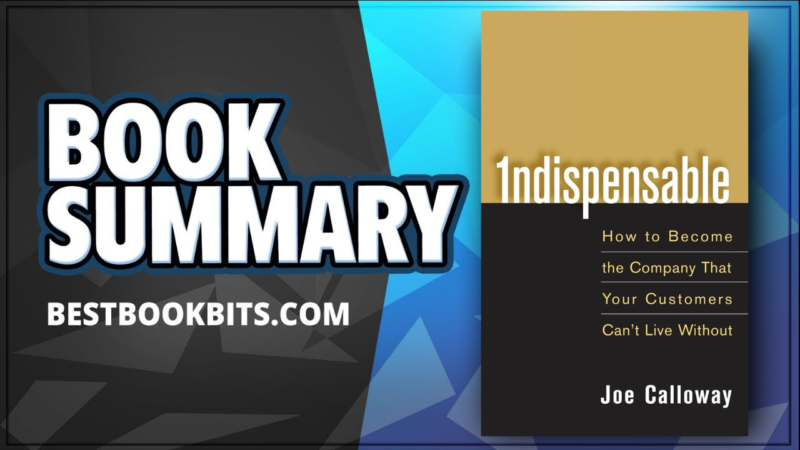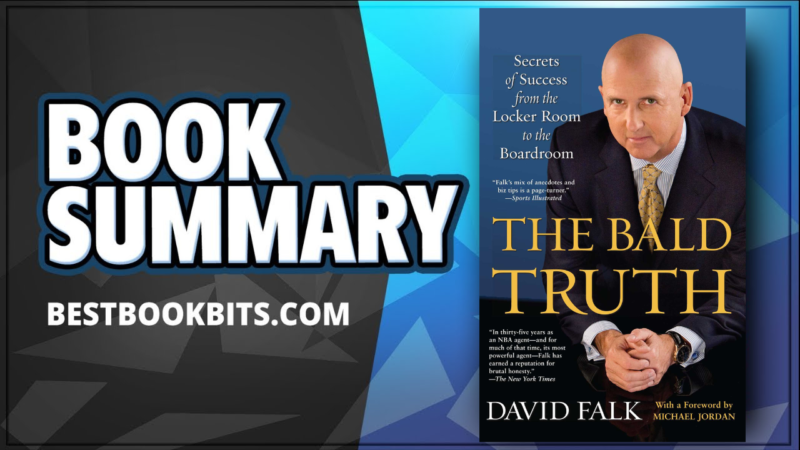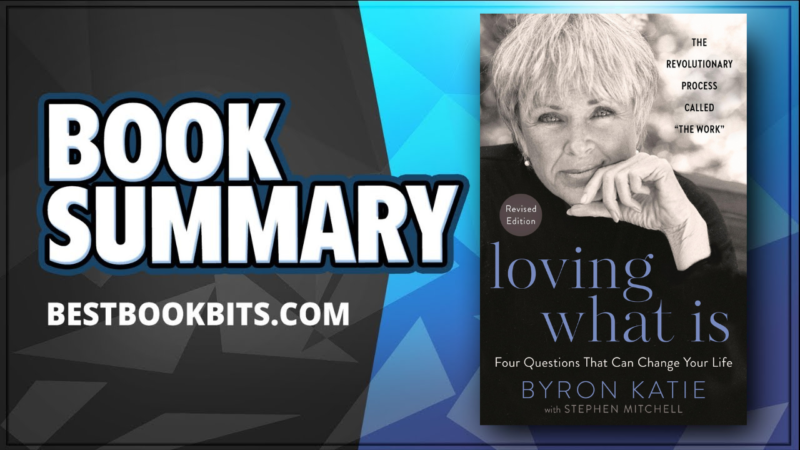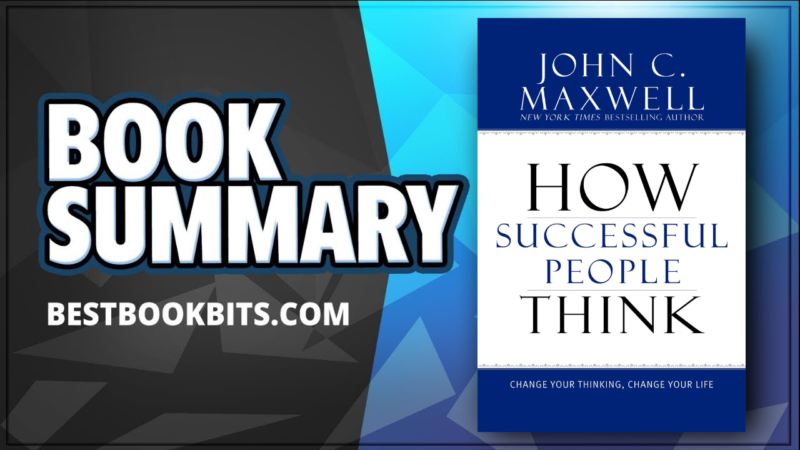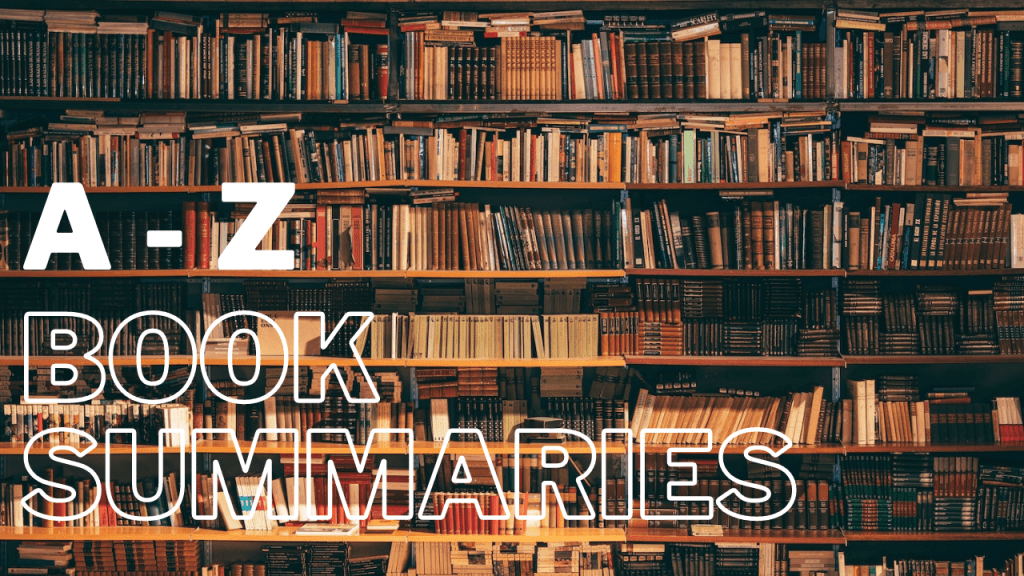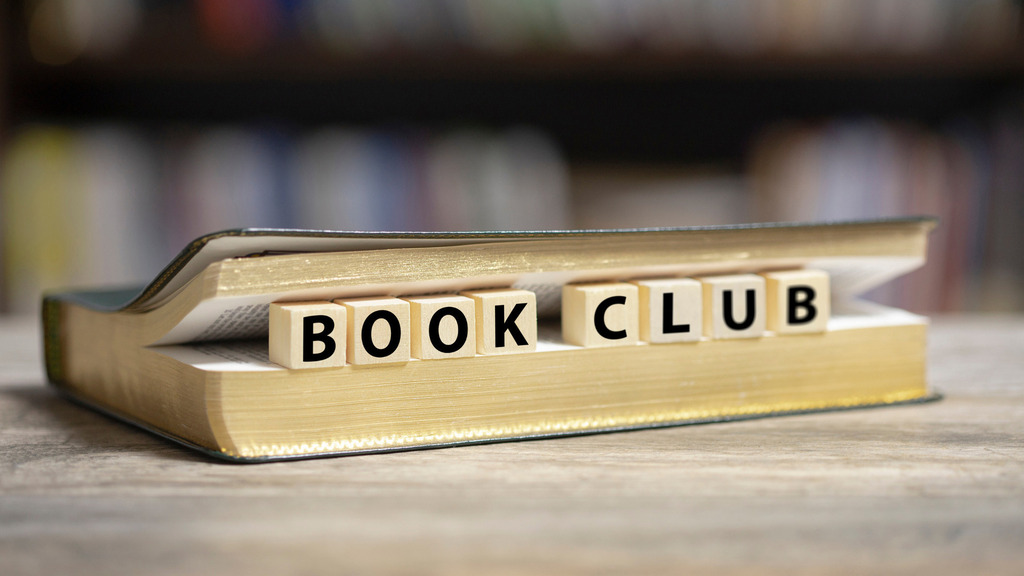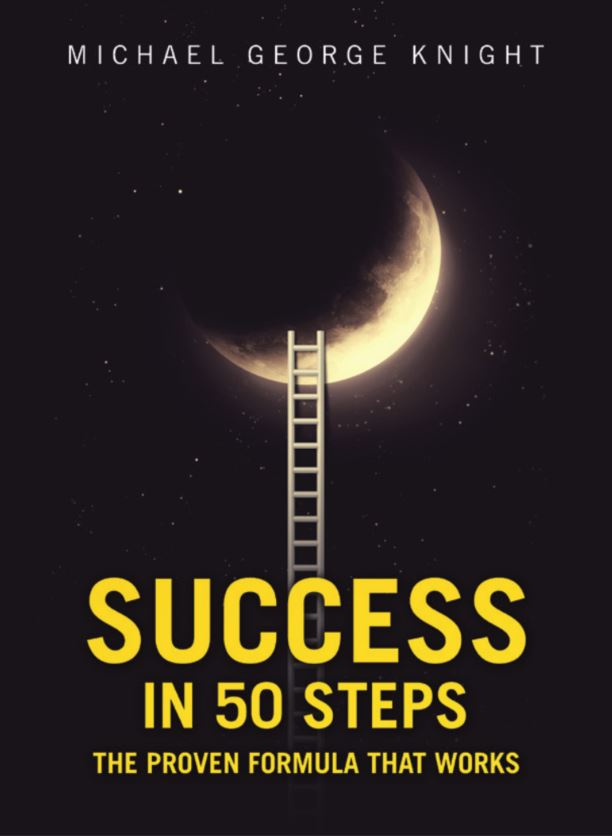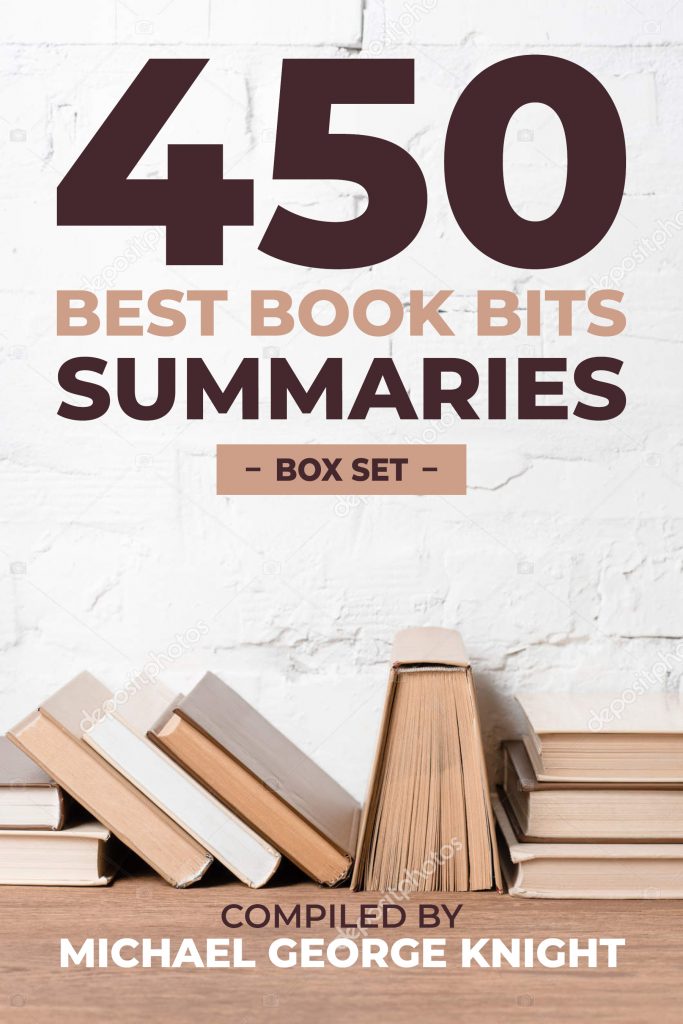
Why Women Buy: How to Sell to the World’s Largest Market by Dawn Jones | Book Summary
FOLLOW US HERE > |YouTube | Podbean | Website
💡 Why Women Buy: How to Sell to the World’s Largest Market by Dawn Jones | Book Summary
Discover how to connect, communicate, and sell more effectively to the world’s most powerful consumers — women. In this summary of Why Women Buy by Dawn Jones, we break down the psychology, motivation, and emotional triggers behind women’s buying decisions.
Whether you’re in sales, marketing, or business, understanding how women make purchasing choices is the key to success. Learn how to build trust, craft the right message, and create a customer experience that resonates.
💬 In this summary, you’ll learn:
The key differences between male and female buying behavior
How emotions influence women’s purchasing decisions
Practical communication strategies for marketers and sales professionals
How to build authentic connections that lead to brand loyalty
👩💼 Empower your marketing strategy and unlock the full potential of the world’s largest market — women.
📚 Watch now to master the art of selling through understanding, empathy, and connection!
Why Women Buy: How to Sell to the World’s Largest Market by Dawn Jones
Why Women Buy provides insight into the buying process and equips readers with the best sales techniques for closing deals with women. The reader will gain the confidence to sell successfully to this $4 trillion market segment.
Introduction
My goal in sharing the techniques for selling to women is to help you be more intentional and effective in your sales process with women while operating with the highest degree of integrity.
When you are more cognizant of your thoughts and intentions towards women, you will be better prepared to handle obstacles and overcome objections that arise throughout the sales process.
Chapter 1 – Recognize How Women Differ from Men
Consumer trend expert, Faith Popcorn, says, “Companies think they’re marketing to women, but they’re not. They’re not talking to women. They don’t know how to talk to women. They really don’t realize that women have a separate language and a separate way of being.”
When you’re talking to a woman in the selling process, remember there is a relational aspect, even if you’re asking her questions. She wants to know at the very beginning of that process that your questions are genuine.
She wants to know that you are real, sincere, and unpretentious. She wants to know you’re going to ask questions that are relevant to her. She wants to know that you care about her.
Step One: Offer an initial solution idea
Step Two: Explore underlying concerns
Step Three: Decide on a plan of action
Chapter 2 – Overcome the Fear of Sales
This is one of my favorite topics because I used to be terrified of certain aspects of the sales process, such as making sales calls. I would have rather had a wasp fly into my car while I was driving down the highway than pick up the phone or walk into an office and make a sales call to some unknown organization—the dreaded cold call. Though I was an able salesperson, I was afraid to pick up the phone and make a simple call.
When it comes to overcoming the fear of sales and replacing the old unproductive patterns of the past with new productive ones, there are three important elements.
Know-how: Knowing how to sell successfully.
Leverage: Leverage is something that propels you beyond your fear.
Vision: Vision is what motivates you to take action even when you don’t feel like it.
Chapter 3 – Operate with Integrity
Perhaps you have heard somewhere in life, “Watch your thoughts; they become your words. Watch your words; they become your actions. Watch your actions; they become your habits or behaviors. Watch your habits and behaviors because they become your character, and watch your character because it’s who you’ve become.”
If a woman believes the salesperson she is working with is disingenuous, she is more inclined to stop the sales process and leave without her prize. This can happen in several ways. She might bring the conversation to a close by saying she’s not interested at this time. Or she could say that she’ll have to come back later. She might even flat out ask for another salesperson or the sales manager.
For most women, the sales process is more than a transaction, depending on the product or service, whether cars, computers or cosmetics, it’s an experience. The bigger the ticket price, the bigger the experience she wants to enjoy—to relive those memorable moments like watching a favorite movie; she wants to savor that enjoyment and tell her friends about it. Anything that interferes with her experience spoils the movie. Which explains why she’d rather leave that metaphoric movie rather than put up with the games of an insincere or incompetent salesperson during her sales experience. A woman’s expectation of experiential service has an impact in retail stores and in the work- place.
The way to gain mastery in sales is to learn, practice, and teach.
Learn your craft: Take the necessary time to study from those who have gone before you. Listen to, watch, read, and participate in teachings that will hone and sharpen your sales skills.
Practice what you learn: Apply the knowledge you gain to your day-to-day work and life.
Teach what you’ve learned: By helping others learn and grow, you come to a whole new level of mastery within your craft.
The way to incorporate learning, practicing, and teaching into your life is to implement what I like to call the triple T’s: tips, techniques, and tools.
Chapter 4 – Ask Great Questions
Many sales-people have experienced a time when they wished they could have taken back their answer or added a great question in conjunction with their answer to keep the conversation flowing and been more effective in their communication. Her “problem” was that her questions weren’t answered, or the right ones weren’t asked. Asking great questions is especially important when selling to women because women tend to ask more questions than men and expect questions to be answered and reciprocated during the sales process.
“Did you know there are three types of questions you can ask for successful selling?” I knew when I asked you this question you could only give me one of two answers: either no or yes. This type of question, you may know, is commonly called a closed-ended or yes or no question.
The second question I asked you was, “What are they?” What are the three types of questions you should ask? This is called an open-ended question. It’s open-ended because you have no idea how the person is going to reply unless you ask a question that has only one main answer, such as, “What is your email address?”
Let’s move to the third question: “Do you want me to give you a clue or do you want me to give you the answer?” This is an either/or question because you’re giving your listener options, like a multiple-choice question. I label these blue questions because blue is like the ocean. It’s vast. It’s unending. It’s flowing. It’s moving.
Chapter 5 – Integrate All Four Communication Styles
The four communication styles are: verbal, visual, tactile (hands-on), and written word. Let’s take them one at a time.
Verbal. According to the University of Missouri, 44 percent of the people you communicate with need to hear instructions. Here’s the challenge. If that’s the only method of communication or sales that you’re using, they need to hear what you’re saying six to ten times.
Visual. This is the fastest way to teach some- one a concept. YouTube and internet videos are so popular because they show you how to do some- thing just like that—in the blink of an eye or the watching of a video clip.
Tactile. This is the best way for people to remember something.
Written Word. According to the Literacy Company, the written word is one of the most challenging learning styles because most adults are reading at a grade school level. Most adults are still reading one word at a time.
Women tend to place a higher value on establishing a relationship and a high-quality buying experience than they do on being loyal to a product or its price.
Chapter 6 – Sell to the Different Personality Types
You’ve got the direct driver type of person. You have the thinker/analyzer person. You have the social extrovert or the innovative type of person. Then you have that relational person.
Direct, driver type people tend to be fast-paced, bottom-line, get-to-the-point. These are your natural leaders. They are effective decision makers.
The thinker-analyzer personalities tend to be more detailed, meticulous, and accurate. They like things in order. I like to say they were born with a drop-down menu in their head. They have processes, and they love to have a place for everything.
The socializer or the social extroverts are creative and innovative people who tend to be fun loving, energetic, expressive, spontaneous, and the life of the party.
Then that relational person tends to be pretty pleasant, friendly, dependable, and calm. They often take on the role of the peacemaker.
Chapter 7 – The Four Stages of Competency
Knowing where you are in your competency level of understanding your audience, the person you’re selling to, and even yourself, is the final technique in this book and the first step to building skill.
Yet there are parts of the sales process that just don’t come together for you. What I want you to think about as I discuss the four stages of competencies is where you are in the different stages of your life, and where your clients are in their understanding of what you’re trying to sell them.
Stage 1: Unconscious Incompetence. This is where you don’t know what you don’t know, and you don’t know that you don’t know it. Name an area in your life where you are unconsciously incompetent. It’s a trick question. You can’t name something you don’t know that you don’t know because…you don’t know it! These are your blind spots.
Stage 2: Conscious Incompetence. This is where you get, what I like to say, the wake-up call. You now know there is something you don’t know that you didn’t know. Just as important, you know everybody around you knows that you don’t know it. Welcome to the wake-up call. With conscious incompetence, it’s embarrassing when you realize you don’t know something you didn’t know, just like in the car situation, you remember all the things you said to the driver that were totally out of line.
Stage 3: Conscious Competence. This is where you take the wake-up call, identify what needs to be changed, and implement the steps to change it.
Stage 4: Unconscious Competence. This is where you’re just doing things naturally without thinking—you have formed great habits for life.
BONUS – Confidence in Selling to Women
Keep in mind that selling to women includes being confident. Now this is not to be confused with being cocky or arrogant, or faking it until you make it. This is just being confident. Coming in knowing that you are listening, you are prepared to learn, and you are also prepared to teach your client what they need. Whether you are displaying this confidence over the phone, or over the Internet, face-to-face, or when sending emails and correspondences, being confident is essential when it comes to successfully selling to a woman and making a living from your talent.
Confidence comes across in four ways including: your voice, your words, your facial expressions, and your credibility.
Voice. Your voice should be melodic yet professional
Words. Your voice says more than your words.
Facial Expressions. The third element in boosting your confidence includes your facial expressions because what’s not being said is being heard.
Body Language. Please note that women’s body language does not mean the same things that men’s does.
Listening. Men listen for facts and figures, often more focused on getting the best deal. Women want the complete story and are more interested in learning about quality and getting the right product or service to suit their needs.
Credibility. The final element of being confident when selling to women is your credibility. Being credible allows the person you’re connecting with to start building trust with you.
FOLLOW US HERE > |YouTube | Podbean | Website
The Content Code by Mark Schaefer | Book Summary
FOLLOW US HERE > |YouTube | Podbean | Website
📘 The Content Code by Mark Schaefer | Book Summary
Unlock the secrets to creating content that truly spreads! In this summary of The Content Code by Mark Schaefer, we explore powerful strategies to stand out in today’s overcrowded digital world. Learn how to turn ordinary content into shareable, influential ideas that build trust, loyalty, and brand awareness.
Whether you’re a marketer, creator, or business owner, this book summary reveals the hidden codes behind audience engagement, social sharing, and content ignition.
🔥 In this video, you’ll discover:
Why great content alone isn’t enough anymore
The 6 key elements of the Content Code
How to grow true emotional connections with your audience
Practical tips to boost your content’s reach and influence
If you want your content to get noticed, get shared, and make an impact — this summary is for you.
🎧 Listen, learn, and level up your content strategy today!
The Content Code: Six Essential Strategies for Igniting Your Content, Your Marketing, and your business
by Mark Schaefer
Named world’s best SEO book by Book Authority and one of the top five business books of the year by INC magazine! Mark has delivered a path-finding book exploring the six factors that will help you break through the overwhelming wall of information density to win at marketing now … beyond content, beyond social media, beyond web traffic and Search Engine Optimization. The Content Code starts where your current marketing plan ends, and provides the launch code for next-level success. The book dives deeply into the true value of social media marketing and the steps companies need to enable to achieve measurable results. A pioneering book that explores the psychology of sharing, it is also highly practical, offering hundreds of ideas that can be used by organizations of any size and any budget. Book highlights include in-depth explorations on the connection between brand and content transmission, a focus on audiences that will move content, practical steps to build “shareability” into all your content, and the new role of promotion, distribution and SEO in a very competitive, digital world. Unlock your business value, unleash your audience, and uncover the six digital secrets of The Content Code.
First the bad news.
People don’t want to share your content, in general. Research shows people don’t usually share content they’re reading online, even if it’s great content. For example, an average Twitter user retweets only one in 318 content links they receive. Facebook reports just one-half of one percent of those who see a content share it. These staggering numbers suggest a miniscule number of the most active users is critical to spreading your content online.
Using the Psychology of Sharing
There’s a lot of hype around creating that people want to share it. Instead of buying into the hype, focus on reliable research that provides accurate insights and even competitive advantages. If there’s any organization on earth that wants to attract page views, it’s a newspaper, so let’s pay attention to how they use the psychology of sharing.
Psychology of sharing #1 To be useful
The number one reason people share is to bring informational and entertaining content to others. More than 90 percent of people carefully consider how the information they share will be useful to others.
Psychology of sharing #2 To define ourselves to others
More than half of people share content to give people a better sense of who they are and what they care about.
Psychology of sharing #3 To grow and nourish relationships
Three in four people share information online because it lets them stay connected with the people they care about.
Psychology of sharing #4 Self-fulfilment
Three in four people share content because it allows them to feel more involved in the world.
Psychology of sharing #5 To get the word out about causes and brands
Three in four people participants share content to rally clothes about a cause, a company, an idea they believe in.
As you read the list, it probably occurs to you that sharing content is a meaningful act, a very personal, intimate and important gesture. It’s nothing trivial at all.
The decision to share content is often a sign of relationships. A relationship with the source, a relationship with a network… even a relationship between the person and a piece of content. Igniting content is a symbol of kindness and caring and a reflection of who we are.
22 practical ideas to unlock the content code
Idea #1 Push the right buttons
Add social sharing buttons to your content site. A recent study showed content with sharing buttons is 700 percent more likely to spread than those without.
Idea #2 Tear down those walls.
Consider removing those singing in with an email or trading even more personal information for content. Those barriers turn many people away. The number varies widely by industry but research shows between 25 percent and 90 percent turn away.
Idea #3 Be entertaining, funny and inspiring.
Happiness is an important driver for social media sharing. Think about the content you like to spread to your friends or online community. A lot of it is joyful, funny or entertaining, right?
Idea #4 Go long.
Every marketing trend points to a need for short, concise content. Yet, the research suggests the longer the content, the more shares it may get, with pieces of 3,000-10,000 words getting the highest average shares. So write short easy-to-read paragraphs and use subheadings and bullet points to break up the text.
Idea #5 Aim for conversation, not controversy.
Without doubt, controversy ignites content. But it’s not a sustainable strategy. Controversy can be used most effectively when it’s associated with a positive cause.
Idea #6 Remember that the most important part of your content is not your content.
Stop writing sucky headlines. You must craft a descriptive, emotive, accurate, catchy and tweet-able headline. This is so fundamental yet it remains a challenge for most creators.
Idea #7 Be visual
Read a piece of text and three days later you’ll remember 10 percent of it. Add a picture and the number increases to 65 percent. Reading is inefficient for humans. Your brain sees words as lots of tiny pictures and then you have to identify features in the letters to read them. It takes time.
Idea #8 Ignite with lists and infographics.
Research suggests a list or an infographic can double your chances that people will share your content. Both lists and infographics intrigue while still promising quick answers.
Idea #9 Boost social sharing with suggested stories.
It takes a lot of work to get someone to visit your site, so once you get them there, do what you can to keep them there. A great way to do this is to refer them to other relevant articles from your content site.
Idea #10 Revive content.
One depressing aspect of content creation is it’s short shelf-life. Content can be great and old even though it’s only two weeks ago. That’s why you need to invest in more evergreen content. There aren’t any fast and hard rules about creating evergreen content but every other month seems about right.
Idea #11 Determine the best posting time.
Don’t fall for blog posts with lists of the best times to post. The fact is it ultimately depends on a number of factors and you need to do the work to figure out the best time for you.
Idea #12 Repurpose content.
Evergreen content is a versatile workhorse and can be repurposed anytime to create new information for your readers.
Idea #13 Focus on feedback and reviews.
Reviews offer powerful social proof that can make or break your business, if you’re not careful. If we’ve never visited a business before, we almost always turn to this crowd-sourced content to decide if we should give a try.
Check out: 10 ethical ways to build social proof in your content
Idea #14 Be practical.
Sharing something useful with others is a quick and easy way to help people out, even if we’re not in the same place. Parents can send their kids useful advice even if they’re miles away. Passing along actionable content strengthens social bonds.
Idea #15 Learn to use hashtags effectively.
Hashtags are arguably the most important innovation in the history of social media. The humble hashtag has become the index card system of the web. It’s social media’s most important way to organize information, discover trends, content and ideas.
Idea #16 Make it look good.
How your content looks is also an important indicator of whether it’s share-worthy. When you head out for a night or fine dining, you don’t expect an expensive steak to arrive with a paper bag and a packet of ketchup. You expect premium content to look like premium too.
Idea #17 Concentrate on brand new research and ideas.
Many of your readers share your content because of the intrinsic value of helping others. Focusing your content on new insights from research, quotes and exciting new ideas will appeal to this psychological aspect.
Idea #18 Encourage comments.
Here’s are some ways:
- End your post with a question.
- Ask specifically for comments.
- Mention influencers with large audiences.
- Notify potential commenters.
Idea #19 Tap into FOMO.
Many people are obsessed with being constantly connected to the web because of FOMO (fear of missing out). Tap into this fear to get people to click and share. One way is to use negative words like ‘stop’, ‘avoid’, and ‘don’t’. Write “30 things to stop doing to yourself” instead of “30 things to start doing for yourself”. The former reasons everyone to find out if they’re missing out something.
Idea #20 Help readers spread ideas to help others.
Research found that the best predictor of buzz was in the brain regions associated with social cognition – thoughts about other people. You’d expect people to be most enthusiastic about spreading ideas that they themselves are excited about.
Idea #21 Include ‘click to tweet’ boxes in your blog post.
This is a fun and easy way to increase the number of tweets you get on your article. There’re several free services that allow you to embed tweetable quotes right into your blog pots.
Idea #22 Add your personality.
To stand out from a sea of content, you need something original. To be original, you need to inject your personality into what you create. Consider these two headlines:
- Five common mistake son Twitter (or) My biggest Twitter catastrophe
- Three great recipes for corn (or) How corn saved my rehearsal dinner
The first headline could have been written by anyone. But the second one comes from the perspective of a real person. It sounds human and connects with humans.
FOLLOW US HERE > |YouTube | Podbean | Website
15 Things You Should Give Up To Be Happy by Luminita D. Saviuc | Book Summary
FOLLOW US HERE > |YouTube | Podbean | Website
15 Things You Should Give Up To Be Happy: An Inspiring Guide to Discovering Effortless Joy
by Luminita D. Saviuc
Based on a phenomenally popular blog post, a simple and counterintuitive approach to finding true joy
When Luminita Saviuc, founder the PurposeFairy blog, posteda list of things to let go in order to be happy, she had no idea that it would go viral, shared more than 1.2 million times and counting. Based on that inspiring post, this heartfelt book gives readers permission to give up–that is, to let go of the bad habits that are holding them back from achieving authentic happiness and living their best lives. Lessons include-
Give Up the Past
Give Up Your Limiting Beliefs
Give Up Blaming Others
Give Up the Need to Always Be Right
Give Up Labels
Give Up Attachment
Give up the PAST
Your past doesn’t have to equal your future, unless you want it to.
If you cling to the past and keep on using it as an excuse for not moving on with your life, then yes, your future will be very similar to your past. On the other hand, if you give up the past and allow yourself to be present and engaged in your day-to-day life, while at the same time having a clear vision of what you want your future to look like, then your future will be nothing like your past. It’s all up to you. You have the power to decide. The future of your life is in your hands
Give up your FEARS
You can’t hold on to fear and expect to feel loved.
If you want to be happy, if you want to experience the many wonders of life, and if you want to feel what it really feels like to be fully alive, you have to let go of fear. You have to tear down all the walls you have built between you and the world around you and you have to allow yourself to be vulnerable. You have to allow yourself to be fully seen. You can’t serve two masters. You have to choose one—fear or love—and based on the one you choose your life will either be happy or unhappy
Give up your LIMITING BELIEFS
Beliefs become self-fulfilling prophecies.
They shape our reality, they make us who we are. And if we really want to create a better life for ourselves and for those we love, we have to make sure that the beliefs we hold on to are serving us well and that they aren’t sabotaging our happiness, health and well-being.
Give up your EXCUSES
A lot of times we limit ourselves because of the many excuses we use.
Instead of growing and working on improving ourselves and our lives, we get stuck, lying to ourselves, using all kinds of excuses—excuses that 99.9 percent of the time are not even real.
When you’ve lived most of your life in an environment where excuses were part of your everyday existence and where most people perceived themselves as victims of their circumstances, it can be quite challenging not to perceive your excuses, fears and limitations as truths. But you have to be willing to let go of your excuses if you want to create something new, something fresh and something better
Give up your RESISTANCE TO CHANGE
The person who risks nothing, does nothing, has nothing, is nothing, and becomes nothing.
Life is meant to be fully experienced, with good and bad, with both ups and downs, and the more you try to keep life from happening by resisting and fighting change, the more you will continue to suffer and the unhappier your life will get.
Change is a natural process. You can’t run away from it, just as you can’t run away from life. And if you try, you’ll miss out on life and you’ll miss out on the great opportunity to know yourself, to be yourself and to love yourself.
Give up BLAMING
The best years of your life are the ones in which you decide your problems are your own.
You do not blame them on your mother, the ecology, the president. There is no peace in pointing the finger and making others responsible for how you feel and for what your life looks like. There is no peace in giving your power away to forces outside of yourself and making them responsible for the quality of your life. There is no peace in putting your life in other people’s hands and expecting them to live it for you.
If you continue to blame outside circumstances for the way you feel and if you continue to put your life in the hands of other people, you will continue to be at the mercy of other people and you will continue to be a victim of your circumstances.
Give up COMPLAINING
Complaining not only ruins everybody else’s day, it ruins the complainer’s day, too.
Complaining, just like blaming and criticizing, sucks us dry. It keeps us in dark places, and it continues to feed this false idea that our lives will never get better until outside circumstances start to change. But the truth is that it’s not the outside world that determines how we feel on the inside, but rather how we feel on the inside that determines how we perceive the outside world.
Give up CRITICISING
Any fool can criticize, condemn, and complain but it takes character and self-control to be understanding and forgiving.
People grow together with love and appreciation, not blame, judgment and criticism. Relationships flourish when there’s respect, understanding and support between the people involved, and they perish when those things are missing.
Our job is not to criticize what others are doing. Our job is to focus our energy on healing, accepting, loving and embracing all that we are. Because the moment we make peace with ourselves, we also make peace with all those things, people, places and experiences that once caused us to feel hurt, unloved and neglected
Give up LIVING TO OTHERS’ EXPECTATIONS
Life needs you to be YOU—the unique being that you were born to be, nothing less.
It’s true that our families, friends and the many people around us expect a lot of things from us, but it’s also true that we have our own heart to please and our own life’s purpose to fulfill. And if we waste our lives trying to be whatever everyone expects us to be, we can no longer honor the relationship we have with our own heart and soul, with our inner divinity, and we can no longer fulfill our own destiny.
Give up SELF-DEFEATING TALKS
You and I are not what we eat; we are what we think. —WALTER ANDERSON
A toxic mind has the power to create a toxic life. It has the power to sabotage our happiness, our relationships and our lives, and it has the power to constantly re-create the same painful experiences, either in the same places with the same people, or with completely different people and in completely different places.
It all starts with you. It starts with how you think about yourself, with how you talk to, and about, yourself, and with how you expect to be treated by those around you and by life itself. And once you give up your self-defeating self-talk, once you purify your own thoughts and your heart, the world around you miraculously gets purified as well.
Give up CONTROL
Our lives aren’t meant to be difficult, but we make them so by constantly doubting ourselves and interfering with the natural flow of life.
Life knows a lot more than we do, because life is a lot wiser than we are. And even though our minds might try to convince us that we need to control everything and everyone, and we need to make sure that things always go our own way, the truth of the matter is that life is meant to be lived, not controlled; people are meant to be loved, not controlled; feelings are meant to be felt, not controlled. And by giving up control and allowing life to guide us, we will be able to experience, understand and know this truth.
Give up THE NEED TO ALWAYS BE RIGHT
Don’t let your ego get in the way.
There is nothing healthy in arguing with someone over who is right and who is wrong. There is nothing healthy in damaging the quality of our relationships and causing a great deal of stress and suffering for ourselves and for others, just so we can be right and label the other person wrong.
Arguing with people over who is right and who is wrong is nothing but a waste of time and energy. Life isn’t about doing things that make sense and feel right for others. Life is about doing things that feel right and make sense for us, and allowing others to do the same for themselves.
Give up THE NEED TO IMPRESS
You already are enough.
We live in a world that teaches us to look for external love and approval—a world that teaches us that in order for us to feel truly happy, we have to please those around us by behaving in certain ways, and by surrounding ourselves with all kinds of expensive and shiny things. As a result, “We buy things we don’t need with money we don’t have to impress people we don’t like,” as Dave Ramsey has so aptly observed.
Your job here on earth is not to spend your life impressing those around you. Your job is to be yourself, authentically and unapologetically, to live your life in a way that makes sense for you—to love yourself and honor yourself more than you care about impressing those around you.
Give up LABELS
Once you label me you negate me. —SØREN KIERKEGAARD
It’s true that we live in a world where labels need to be used so that we won’t have chaos and madness present all around us. And it’s true that many of the labels we use are meant to help us manage and guide our conduct, to navigate the many decisions we have to make and to contribute to a clear and healthy communication between us. But it’s also true that labels are often meant to divide us from one another, creating a false sense of separation between us, causing us to perceive some people as being more important and more valuable than others.
We are all in this together. This planet belongs to all of us, and there isn’t one human being on this earth who is more deserving than another.
Give up ATTACHMENT
Learning to live is learning to let go.
When you hold on too tightly to everything and everyone, when you desperately try to cling to things, people, places and experiences, you take the life out of them and you keep life from taking you where you need to go. Everything in life changes. Nothing stays the same. And the more you try to cling to things, desperately trying to control and change the natural course of life, the more you will suffer and the unhappier your life will get.
Indispensable by Joe Calloway | Book Summary
FOLLOW US HERE > |YouTube | Podbean | Website
- Indispensable: How To Become The Company That Your Customers Can’t Live Without by Joe Calloway
- A five-step strategy for turning a commodity into a necessity
When products and services become interchangeable, price becomes the ultimate determinant for consumers. Indispensable shows businesses how to break out of that cycle by using The Five Drivers-a strategy that takes companies to the next level of performance. Renowned business consultant Joe Calloway looks at how real companies have made their product or service “mission critical,” and satisfied customers in the process.
Indispensable goes straight to the heart of the issue and reveals how successful companies-of any size, in virtually any manufacturing, selling, or service endeavor-achieve market leadership through The Five Drivers of fierce customer loyalty. Indispensable shows readers how to:
Create and sustain momentum: overcome organizational inertia and keep moving forward
Develop habitual dependability: make consistency of performance a defining characteristic
Connect continuously
See the Big Picture Outcome: create compelling customer experiences
Engage, Enchant, Enthrall: make magic in the marketplace - Stake out your turf and master it
- Eg 3 pizza restaurants lined up on the same street: One with huge sign that screamed “Best Pizza in the State”, the next “Best Pizza in the City”, the next with a very small sign “Best Pizza on the block”.
- Your turf may be a product category or an area of expertise.
- The goal is to become that default choice in the minds of your customers.
- Get them to act on instinct. Cause tunnel vision, stop them thinking.
- Today’s customers place high value on dependability and consistency of performance
- Many customers don’t have the time, patience, or money to waste on any company that can’t get it right the first time
- Focus on one thing. Master the category. Become a category of one to your customers. Ask:
- What do we do best?
- What do we loveto do?
- What do our customers value?
- A classic mistake in business is to go after more customers by expanding your product or service offerings too far. Before you start to think outside the box, take care of what’s inside the box. Master the basics before you spend money, time and energy on innovation.
- Before diversifying to add products and services to develop new business, master the product and service you already offer. Getting better at your core will provide you with a much greater return in new customers and increased business with existing customers.
- You can be great at something you absolutely adore doing, but if nobody is willing to pay you for it, what you’ve got is a hobby, not a business
Context for employees
- Create a context for employees so they can execute to the best of the ability in context. Help them see the link between what they do day in, day out, and how the company is trying to change the future through her and her contributions. That creates a powerful force to be reckoned with.
- Tell them they cannot fail. Empower them to take risks, try new approaches, find their own way. It is so encouraging to work for someone who truly believes in you and supports your decisions
Six New Basics
- Say “why not” continuously.
- “Discovery consists of seeing what everybody has seen and thinking what nobody has thought”
- The restaurant boss who thinks it’s his job first and foremost to make his employees job the best they have every had
- Why not use products and services for which you’ve always charged to invite customers into a much more profitable relationship based on higher margin sales? This provides indispensable service that locks them in (only a very small number of customers take advantage)
- Get back inside the box.
- Instead of saying “let’s be different”, say “let’s be really good at what we do first, thenwe can be different.” All the differentiation in the world will be wasted unless you have mastered your core business
Partnerships
- Do clients come to you for advice on things that are outside my range of services? They must trust your judgement
- What other businesses in your market are complementary? Give your product or service away through them. Generate interest for them and new customers for yourself. Who else do your customers do business with?
Selling is dead
- The idea of talking someone into buying your product is dead. It’s cumbersome and inefficient.
- Get to know your prospects business inside out. It’s not selling, it’s about people buying.
- Find out what your clients objectives are, and offer a product that helps them meet those objectives
The 5 Drivers of behaviours that result in becoming indispensable
- Create and sustain momentum (Decide. Take the next step, then the next, then the next)
- Develop habitual dependability
- Continuous connection
- Big picture outcome
- Engage, enchant and enthrall
More Ideas
- When you create an indispensable business, you create hundreds or thousands of walking commercials – infinitely more powerful than a full-page ad
- Create value, then give it away. If you have good stuff, people want more. Charge them for the high end.
- Give your best effort everytime. It might be the 100th mortgage of the week, but it’s my only mortgage in the world
- Be willing to be wrong. Mistakes always give you information.
- Wake up and smell the personalisation. It’s better to initiate one hundred incredibly personalised marketing efforts rather than one thousand “one-size-fits-all” version.
- Stay in front of customers and prospects with something that they can learn from, that is valuable. When they are ready to buy, you are right there staring them in the face
- Don’t just claim in some ad or mission statement that you exceed my expectations. Make me say “Wow. I never would have expected that.”
- Become one less thing to worry about. Provide consistent performance, dependability. Instil great confidence that issues will be resolved when they are handed to you. Make their lives easier.
- To do: Some up what you do for your customers in six words or less is more powerful than any 3 paragraph mission statement
- Look at other indispensable businesses and look beyond the differences to figure out what your version of what they do is.
The Bald Truth by David Falk | Book Summary
FOLLOW US HERE > |YouTube | Podbean | Website
The Bald Truth; Secrets of Success from the Locker Room to the boardroom by David Falk.
The Bald Truth; Secrets of Success from the Locker Room to the boardroom was written by David Falk. He was the agent for Michael Jordan. He was also the agent for Alonzo Mourning. Which was the first 100 million dollar deal ever done in the NBA. He was Patrick Ewing’s, John Thompson, and Mike Krzyzewski to name a few other of the other big names he represented. The foreward in the book was written by Michael Jordan.
Don’t be a prisoner of your own reputation: Succesful people remain consistent in their value system but flexible in reaction to changing market conditions.
Don’t try to be a spiritual advisor: A leopard doesn’t change its spots. People don’t change leopards.
Don’t try to run a democracy: Treat everyone fairly but don’t treat everyone equally.
Its better to have a good enemy than a neutral friend: In crutch time you must know how the people around you will react. The most dangerous enemy is an ally who deserts you.
A combination of creativity and preparation is essential: Practice make perfect as long as you don’t do it the same way every time. preparing for major negotiation or representation develops confidence, but preparation without inspiration limits your ability to adapt your performance to unexpected challenges.
Sacrifice short-term benefits for long-term success: The Spurs have been the most successful franchise in the NBA the last few years. The Spurs have learned how to lose games during the regular season in order to be well rested and primed mentally in the postseason. Don’t win the battle, win the war.
Long term success demands discipline and accountability: Winning a marathon requires complete discipline mentally and physically. If you alter the strategy in response to short-term bumps, you probably wont finish the race.
Be true to yourself: A jack of all trades and master of none is known as a dilettante. Play to your strengths and don’t be afraid to seek help when you need it. Be authentic.
Know when the race is over: Great coaches learn to not run up the score. Whatever temporary satisfaction you might derive from a rout you will likely pay for the next time you face the opponent. Win the game and then walk away gracefully.
Say what you mean, and mean what you say: If the truth is hard to find, players will run from the coach instead of running for the coach.
Business is not a popularity contest: In the final analysis, it’s not what they want to hear. It’s what they need to hear.
The truth , the whole truth and nothing but the truth: The truth is the most powerful medium of persuasion. “Actually sir, it’s not like a Xerox. It is a Xerox.”
Don’t just see what is happening; anticipate what will happen: Individual who can anticipate what will happen next can translate that opportunity into success.
Limitations are obstacles, not barriers: Even the most careful planning cannot preempt last-minute changes that challenge execution. Successful managers see these limitations, whether they be increased competition, regulatory changes, increased time constraints, or any number of business issues, as challenges not barriers. Their ability to shift on the fly enables them to navigate these limitations that act as total obstructions to less nimble operators.
Intuition and ingenuity define the road ahead: Since what lies ahead of us can’t be determined with certainty, successful managers will find their way paved only be creativity, feel, and ingenuity.
Understand the long-term impact of your actions: The most basic law of physics dictates that every action has an equal and opposite reaction. But like energy stored up in a volcano, the reactions sometimes takes place years in the future and with unexpected force. Don’t expect that the only impact of your decisions will be then knee jerk variety. It is more likely to be the ripple effect across the entire pool of your business.
Brand your product to differentiate it from the competition: Imitation is the highest form of flattery. We live in an age of brand names that competitors try to mimic, and often the lines between Bentley and Chrysler are blurred. Learn how to separate your company from the competition through creative branding so that the boundary between your products or services and the competition will be so distinct as to require a separate language and customs.
Stay true to who you are: Long term productivity requires that we operate within our strengths even if our critics find fault along the way. Changing your operating style to satisfy short-term criticisms threatens the long-term stability of your organization.
Don’t win the battle only to lose the war: In the history of NFL football league, only one team has ever enjoyed a perfect season, the 1972 Miami Dolphins. As recently as 2007, the New England Patriots didn’t lose a single game in the regular season, but the pressure mounted to eclipse the Dolphin’s record and the Patriots lost in the Super Bowl. Success is generally defined by reaching specific goals but often we must sacrifice certain short-term success in order to arrive at our desired destination. Did chasing a perfect season interfere with the ultimate goal of winning a championship?
You must be willing to walk away: Negotiation 101: In order to attain the ultimate deal, you must be willing to walk away from intermediate opportunities. The necessities an honest appraisal of the strength of your position. A man on life support can very well afford to pull the plug.
Goodwill is the currency of relationships: In an age of instant information and access, competing parties will frequently find themselves in very comparable negotiating positions. What enables them to cross the divide is goodwill.
Goodwill is the lubricant that greases deals: Highly intelligent and successful people are unlikely to persuade colleagues and competitors of a similar bent through facts, figures, or even negotiating ability to do something they don’t feel comfortable doing. What enables them to fuse two very powerful and competing forces is goodwill.
Goodwill can be your most valuable asset: Unlike cash, inventory, or other hard assets that can be measured with tradition metrics, goodwill frequently can be the ultimate determinant of success and failure in business. Developing and maintaining a reservoir of goodwill among employees and even competitors is often more valuable than more tangible assets.
Goodwill must be earned before it can be employed: Goodwill is most often earned by doing the right thing when there is no pressure to do it. By going the extra mile to be supportive, respectful, generous, and loyal the executive earns the most valuable commodity.
Goodwill cuts both ways: By failing to recognize the small things that you can do to create goodwill, executives often plant a negative seed that grows into reverse goodwill. When the leader most needs to call upon his troops for support, a vote of confidence, or double duty mission, the obvious prior failure to do the right thing, to make the small gesture, rebounds with unexpected negative force.
Don’t be afraid to let the customer know when he’s wrong: In an age of increasing specialization, customers look to their dealers, brokers, and advisors for specialized advice. Often the customer has strong opinions about his purchasing options and just as frequently these opinions are based on a faulty set of assumptions. Never let your desire to please the customer interfere with your responsibility to give him candid advice about his decisions. Otherwise his next purchase will be his last purchase.
Short term pain often translates into a long-term gain: Most individuals steer a wide path to avoid confrontation. But a trusted advisor is like a personal trainer, sometimes where there’s no pain there’s no gain. In order to avoid a result that would ultimately constitute an unacceptable level of risk or damage to the client, the advisor must be willing to deliver the hard facts up front.
Truth or consequences: While experience is sometimes the best teacher, there are situations when a bad experience can be fatal. An individual facing such a critical decision must be informed in the strongest terms that a wrong turn will lead right over the cliff.
Remember the Golden Rule: He who has the Gold Rules: Your ability to reach a successful conclusion is a direct result of the amount of leverage you have and your ability to communicate that leverage.
Know when to hold: A great point guard never gives up his dribble. Control of the ball gives him control of the game. When you have the leverage you should never settle for second best.
Know when to fold: Modern fighter jet costs upwards to 100 million dollars. Their pilots are trained to control the aircraft under all types of adverse conditions. However, when certain indicator lights come on they are taught to press the ejection seat. The same is true in business.
Know when to walk away: In Vegas the house always wins. A savvy gambler knows when to get up and leave so they keep their money. When you’ve attained most of what you need to make a good deal, learn to walk away and be a good winner.
If you have the power you don’t need to use a hammer: In fashion it is said “If you’ve got it flaunt it” But in business if you’ve really got it, then everyone knows you’ve got it and there is no need to flaunt it.
You control your own destiny in a negotiation: Almost every variable in a negotiation: where you meet, how you dress, how many people are in the meeting, has an impact on the final result. Take control of the variables and you will take control of the deal.
Avoid unnecessary confrontations: Really successful negotiators show how smart they are, not how tough they are.
Both sides have to win: In business even if you win the fight, it is important that your opponent wins some points in order for him to accept the deal.
You need a game plan for success: A successful negotiation depends on a well thought out game plan that conceptualizes the path to a deal.
How do you spell success? The last player to hit .400 in Major League Baseball was Ted Williams more than sixty years ago. In other words, Williams failed to hit in 60 percent of his plate appearances. Nevertheless, hitting .400 is considered iconic achievement in baseball. Learn to define what success means in your business.
Conventional wisdom is just an element of the status quo: Successful people continually challenge the status quo: Some people see things as they are and ask why? Others dream things that never were and ask Why not? Dare to be great.
You must know the difference between talent and value: Talent is a constant, value is a variable. Being cognizant of market forces and trends enables is to differentiate our product. The textbook case is Starbucks selling a 20 cent cup of coffee for $3.
Artificial constraints don’t work: In a free market economy, external regulation distorts the natural equilibrium of the market. The distortion creates opportunity. Look for pressure points in the system.
Preparation, instinct, and confidence are the keys to success: The most instinctive hitter in baseball still studies the pitcher. His intense preparation enhances his confidence on his own abilities and bolsters his performance.
Loving What Is by Byron Katie | Book Summary
FOLLOW US HERE > |YouTube | Podbean | Website
Loving What Is by Byron Katie
Do you feel under pressure? Are you upset with life, or tired by the world and all its issues? Many people feel that way, and sadly, most are do nothing and accept a nervous living – as there looks to be no choice.
Still, there are choices! An origin of stress or worry that can’t be beaten doesn’t exist; you only have to behave rightly to things that make feel you under pressure.
This summary tells about a basic way which called ”The Work,” to handle life’s stresses. You can live a delighted and more completed life, by understanding the easy steps of ”The Work.”
1 – By understanding and dominating your own mind, you can handle your stress.
You’re in a relationship for a long time and have been blissful for years. But you’ve begun to think that your mate is not in love with you no longer.
Your stress increases as you try to devise methods to make your mate love you again, in this imaginary status. But that’s unfeasible! So you must carry your stress and sorrow during living. Is it true?
False. Stress isn’t caused by your cases or individuals’ in your living, it’s caused by the explication of cases or the effects of friends and beloveds.
So the thing that makes you sad is not your mate’s artificial love but it’s your comment on your mate’s feelings. You’ve actually figured out that your mate is not in love with you no longer, according to her attitude. Whenever she doesn’t remember to give a goodbye kiss to you, thoughts in your mind becomes like that: She doesn’t care about me.
How can you tide over this status? Okay, stress is a creature of your mind, so you have to modify your mind. Now, ”The Work” gets in.
Begin by noting down the thoughts that are disturbing you. On our imaginary example, you’d note, ”My relationship seems to fail because my mate is not in love with me anymore.”
Secondly, by questioning yourself with four basic inquiries, examine your noted thoughts.
Is this actually right? To be certain that you’re not so hasty, analyze your mate’s movements again.
Can I be exactly certain of its reality? Think of the possibility that there is another comment that explains your mate’s actions.
What does this thinking make you do? Occasionally, we provide ourselves more stressed, when we’re worried. You may be looking for proof that your mate’s not in love with you because you’re actually paranoid.
Who would you become without this idea? In this status, you’d be more delighted and take pleasure in your relationship more.
The replies to these four inquiries will make you understand your bad thoughts, so you can start to do something to feel good.
2 – By transforming stressful thoughts into the opposite, you can understand many about yourself and your emotions.
After you’ve replied The Work’s four inquiries, you have to understand more the thoughts that make you stressed and sad.
Now, Turnaround comes in.
The Turnaround is the final footstep of The Work. It’s about focusing on turn your thinkings around to find profound facts about yourself, your emotions and your state.
In case your thoughts make you think that your mate is not in love with you and your relationship is failing, turn those thoughts around and view the event.
You have to try nearing your issue from a dissimilar corner. Perhaps your mate actually loves you and you’ve been just thinking incorrect way.
Then, come close to this recent thought with the same old inquiries from The Work. You’ll win a new grip into your instability when you deeply analyze the reverse of your first thoughts.
Don’t stand there! Count all probabilities and turn them all around, then view how these dissimilar events lead you sense.
For instance, is there a probability that it’s really you who is not in love with your mate, and this is the origin of disturb between you two? Or in fact, do you have a problem with loving yourself? Do you feel upset about another issue in your living and reflecting that on to your mate?
You’ll have dissimilar emotions and effects to all of these probabilities so you have to think of them meticulously.
At the end, which idea or emotion should be able to lead you? There is no certain rule: let the thoughts that are actually right for you to lead you. Walk with what senses right.
”The Work” just gives you choices – it doesn’t bring you a simple answer.
3 – Don’t let the things that you can’t modify to stress you – be interested in things that you can modify.
Have you ever been mad just because the weather was inappropriate and you had to give up important plans like a birthday BBQ? Did you damn your chance, yelling ”It can’t rain, it’s not equitable!”
Surely, we’ve all sensed like this at a point or another. But you’re just trying to battle forces that you can’t control while you feel upset with bad weather.
The facts don’t change by your disappointment. You won’t be helped by stress – it only will provide you to feel upset, frustrated and weak. You just can’t do anything about the weather!
The most important way to reach bliss isn’t modifying the truth, but it’s discovering your real space in the truths you can’t modify.
When we face huge issues, such as war, starvation or environmental pollution, we generally feel choked. These are strong powers, and there is almost nothing we can do about them as a single person.
You will be unsuccessful in case you try to unravel the world’s issues alone. You’ll just be mad at the individuals you think is liable. That rage may motivate you, but it may leave you in stress as well.
In place of that, be sure about the small alterations you can handle. When you see that you can provide a distinction even in a minor method, you’ll be feeling good.
Your movements will also seem to you simpler – you’ll discover things that you can do without pressure, fury or disappointment.
For instance, you can’t stop a big firm from cutting down the trees, but you can stop using what they produce. You have to understand that you can do something concerning the issue and you’ll sense much more pleased.
You can use ”The Work” in all parts of living – job, family, relationship.
An idea that says The Work is pretty straightforward to help you solve life’s huge issues may come to your mind. Absolutely, it may make you get over your fears or repair your relationship, but it can’t make you gain money or solve profession problems, right?
False again!
4- You can be helped by ”The Work” in all parts of your living: companionship, love, career or other things.
Imagine Joe is battling in his work partnership. He feels stressed, as he considers his work associate is not that authorized for the work, particularly about accountancy. His thoughts about his associate are building coldness between the two people.
By trying to do what The Work suggests, Joe could win a lot of things to examine his career status.
What if Joe turned his ideas around when he may consider his associate can’t do anything? Joe may become aware of that his associate is not strong in some parts but definitely powerful in others. Even if his associate has problems with accountancy, he still may be inevitable.
In case Joe would be interested in more positive ideas, he wouldn’t only feel good than he considered, he’d be running his job more actively as well.
In all parts of your living, when you do what The Work suggests, you’ll see that you’ve been hurting yourself for nothing. Sometimes the senses that hurt us aren’t that clear, and sometimes they’re so clear that we don’t even understand that it’s our senses that are building the issue!
Despite all your rough work, do you battle to catch profession targets? If so, think of what you’re really working for. Do you actually have to be financially accomplished to be pleased? If the answer is no, you may be taking yourself under pressure to work for something you don’t really wish or need.
Are you certain you aren’t trying to catch bliss instead? ”The Work” will make you discover your real way!
Loving What Is: Four Questions That Can Change Your Life by Byron Katie Book Review
You shouldn’t let defiances of life to wreck you. Stress, dread and other bad feelings all are creatures of your comments on your perimeter, not the perimeter itself. Apply ”The Work” to understand deeply your own senses. When you take control of your brain, you’ll discover internal peace and really be delighted.
Note down your thoughts.
If you can read your thoughts, you can understand them deeper! Do don’t perform The Work in your mind, note down your opinions so you can exactly grip everything that comes to your mind.
The Fun Formula by Joel Comm | Book Summary
FOLLOW US HERE > |YouTube | Podbean | Website
The Fun Formula: How Curiosity, Risk-Taking, And Serendipity Can Revolutionize How You Work by Joel Comm
The demands of work and the fast-moving pace of technology wear heavily on employees and entrepreneurs alike. The “hustle and grind” lifestyle that most of us have bought into is simply unsustainable, leading to physical ailments, emotional burnout, and a darkness in the soul. Joel Comm has found a better way.
In The Fun Formula, Comm demonstrates that the best path to success–in work and in life–is to focus on our passions, curiosity, and the things that bring us great pleasure. Doing so not only leads to more dramatic results, but to a more fulfilling life. Through stories and anecdotes from Comm’s life and those of others, famous and not, The Fun Formula reveals how subtle changes in our thinking and routine can enable us to design the life we truly desire: one of significance and joy.
A New Approach to Life
How many times has someone told you what you should do about something? Maybe you’re even guilty of doing it to someone else. Joel did it (so did I). But Joel proposes that you don’t ever let anyone “should” on you. Don’t let anyone tell you that you “should” write this or go there or be with this person or get married or get divorced or move here or take this job or leave that job. When we hear that “should” as adults, what we’re actually hearing is people telling us how to live our lives.
The bottom line is you get to decide. You’re in charge. As the great American philosopher Jon Bon Jovi said in his hit song, “It’s My life!” Ultimately, nobody else has to answer for your life but you. When you recognize that truth, you’ll be empowered to change. You’ll throw off the fear of change. You’ll be prepared to walk through any of the doors that appeal to you. And you’ll have a whole new attitude toward life.
Where Do We Find Fun?
A good place to start looking for your fun is with a list of all the things that make up your life and asking yourself how happy you are with each of them. Really evaluate how you feel about the current state of your life.
It could be playing music. It could be writing. It could be painting. It could be debating. It could be helping others. There are so many different ways that we can demonstrate our gifts in the world. Go back to what used to make you happy—whether it was last week, last year, a decade ago, or when you were a kid. What did you do as a child that brought you a sense of joy and purpose? There are clues there. Our life leaves little bread crumbs that lead us to where we should go.
Working Hard Versus Working Smart
In a world where busyness is something to be admired and hard work something to be respected, it’s not surprising that people are afraid of free time. Those leisure hours produce guilt. We feel that we’re stealing time from our family or from building our dreams. By the same token, we feel wrong about achieving results from little effort. We’re so used to the idea that rewards only come from hard work, that if we make a six-figure deal after outsourcing the hard stuff and sending a few emails, it feels unfair.
Certainly there will be times when you have to “hustle.” Open a new restaurant, and you’ll be putting in long hours at the beginning. There are seasons when long hours are necessary. But at some point, even that restaurateur will have to step back, hire a chef, and trust someone to manage the restaurant while they reap the profits and look for a place to open a second location. The alternative is high blood pressure, exhaustion, and broken relationships.
Today, something that sounds too good can still be true. In this day and age, you really can just send a few emails. And if they are the right emails, sent to the right person at the right time—if you get your leverage just right—you can close the big deal. The old idea that the more people you call, the better your chances of making sales remains true, but not in quite the same way. Today’s data economy means that we now know exactly who we should contact. Busyness no longer equals productivity. Smartness produces results.
Go Solo And Smart
Being a solopreneur means that you are the boss and the buck stops with you. It doesn’t mean that you’re a business failure. It doesn’t mean that you’re incapable of growing your business. It means that the business you want to lead is small and agile. It means that you can take opportunities as they arise.
Likewise, Joel has discovered that the more organic the unfolding of his businesses, the more likely he is to succeed in them and have a happier life along the way. He said, “If someone were to ask me my ten-year plan or even my five-year plan, I’d have to laugh. I don’t have a problem with those who set long-term goals; it’s just that I prefer to leave my options open. And the old adage has some truth to it: The best-laid plans of mice and men often go awry.”
Work and Play Are Made to Go Together
One of the reasons we lose our sense of playfulness is that we try to protect ourselves from being seen as we really are: a human being who is beautiful and wonderful, but also beautifully and wonderfully flawed and frail. We make mistakes and shame kicks in. We fall down and we’re embarrassed.
It’s uncommon for Joel to get on stage or do a live video without scripting. Sure, he has a general sense of what he’s discussing but because he’s not following a particular script he’ll often end up putting his foot in his mouth. And when he does, he’ll stop, slap his head, turn to the audience and say, “Did I just say that? I really just said that, didn’t I?” It’s real, and it turns out people like it too. They relate to people who are unafraid to laugh at themselves.
The Importance of Showing Up
People often say they’re starting a new business when what they really mean is they’re building a website or designing a business card or hiring someone to make them a logo. But that’s not what matters the most in creating a new venture. The real work is going out, meeting people, getting customers, and getting your ideas out there, even if nothing sticks for a while.
The more people you talk to, the greater the chances that you will create a fun new opportunity, because you never know what will stick, either for the person you meet or for yourself.
Man Is a Three-Part Being
We are physical; we have our body, which is our mobile home on this earth.
- We are emotional, which is our mind, will, and emotions.
- We are spiritual. A spark of the Divine within us is made to live eternally.
The three are designed to work together toward the healthiest you can be. The best way to take care of all three of those parts is to lead a life with meaning, and it’s never too late to start.
It’s Never Too Late
As long as you have a pulse, you have time. There are plenty of stories of people who didn’t start to reach their goals until later in life. Martha Stewart didn’t publish her first book until she was forty-one. Vera Wang only became a designer at forty. Ray Kroc was over fifty when he bought his first McDonald’s. Colonel Harland David Sanders didn’t start selling his Kentucky Fried Chicken until he was sixty-five. The list goes on.
Nothing Happens Until You Start Doing
It starts with that mind-set shift, with abandoning old ideas that you’ve discovered haven’t worked or are past their sell-by date. You might find that you don’t want that big house, and if you sold it and moved ten miles outside of the city, you could be happier. If you quit that job and did something else, you could still make it. But nothing happens until you do something. You have to take action.
It’s okay to take risks, if those risks move you forward. It’s okay to change your mind, if you find you were wrong or if the situation changes. For Joel, he changes my mind so regularly that he’s become used to not planning too far ahead so that he has space to live today and to take advantage of the right opportunities, the right people, the right place, or the right things present themselves.
You Can’t Connect The Dots Looking Forward
Many of the greatest successes occurred when people went off the rails, not building on a foundation but creating their own. Only in retrospect can we say that Mark Zuckerberg’s decision to leave Harvard to focus on Facebook instead of completing his degree first was a good idea. He took a risk. Part of following a dream is having the courage to create your own models of action, to find your own way of doing things.
Not every trail has been blazed. Not every signpost is marked. Just because we’ve mapped the world doesn’t mean that all the paths have been laid. The sea bed is full of treasure and sunken ships and species we haven’t discovered yet. As long as there are people with big dreams and big ideas, there are new places to go—and a time to set sail.
There’s More to This Life
People often realize too late that there’s more to this life. The later we realize it, the greater the regrets, and regret is a horrible thing. We all have regrets. We’ve all done something we wish we hadn’t. But no one ever looks back and says: “I had too much fun. I enjoyed my life too much. I enjoyed what I was doing, and I enjoyed the people I was with. I should have spent more time in the office.”
The worst regret we can ever have is to have never tried, to have never attempted to reach what we hunger for. And doing that sometimes starts with formulating new dreams and new hopes based on our new circumstances.
How Successful People Think by John C Maxwell | Book Summary
FOLLOW US HERE > |YouTube | Podbean | Website
How Successful People Think by John C. Maxwell
There is one thing that most successful people have in common: they are not afraid to carve out their own path and to think outside the box. But the journey on this unique path can sometimes be lonely. After all, humans are a sociable species. People need to feel that they belong somewhere, that they fit in, but the price of being socially accepted can consist of falling in the accepted patterns. Striking out on your own, questioning common notions, and going against the grain will probably not win you many friends.
Yet imagine where we’d be without if all the brilliant people had kept their ideas to themselves, instead of sharing them with the world. When Copernicus claimed that the earth was not at the center of the universe, his contemporaries thought that he was mad. But he was brave enough, and maybe even a little mad, to stick to his guns and now, we are forever in his debt. It is safe to say that tenacity and creative thinking are essential when it comes to success. But, as John C. Maxwell shows, you don’t need to be Galileo or Einstein to have good ideas. In fact, creative thinking is a skill that can be learned by everyone – all it takes is a bit of practice and knowing the right techniques! Here are some of the most important things that you’ll discover throughout John C. Maxwell’s How Successful People Think book summary.
- why you have better chances to succeed if you learn how to be more empathetic;
- what Alfred Nobel did after reading his own obituary; and
- what John Lennon and Paul McCartney can teach you about teamwork and collaboration.
HOW SUCCESSFUL PEOPLE THINK CHAPTER #1: People who see the big picture know how to empathize because they are constantly learning.
Jack Welch, the CEO of General Electric, always reminds his employees that building good relationships with clients can be more important than individual sales. But why is that? Because he knows that the key to achieving long term success is seeing the bigger picture and leaving the nitty-gritty aside. But how can we change the way we see things? By learning as much as we can. People who think big are always looking for learning opportunities.
They enjoy visiting new places, meeting new people, and honing new skills. To achieve the right mindset, the author uses the following technique: he starts his day by checking his schedule. He then tries to find new learning opportunities based on his daily tasks. Once decides which of his daily activities will present the opportunity to learn something new, he mentally preps himself to be focused. In other words, he does everything in his power to be on high alert and receptive to everything that is going on around him.
For example, when he had dinner with Dave Wannstedt, a National Football League (NFL) coach, he was well prepared. He knew that he had a great learning opportunity, so he used his time with the coach to ask as many questions as he could. When the dinner was over, Maxwell had a lot of brimming new insights.
This is a great habit that anyone should take up: starting the day by looking over the itinerary or the schedule for a few minutes and asking oneself which of those tasks are most interesting and which of them present great opportunities to learn new things. It is always important to make an effort to see the bigger picture because this can give you an insight into how others see the world.
In other words, this can make you more empathetic. And that’s great, especially when it comes to your relationships: whether it’s your partner, your clients, your friends, or even your children, empathizing with other people will help you understand their actions, their needs, and the things that they want to achieve. Ultimately, seeing the big picture helps you understand and learn things that are beyond your own narrow interests.
HOW SUCCESSFUL PEOPLE THINK CHAPTER #2: By doing your homework and by thinking realistically you can achieve clear targets.
What does the term ‘reality’ mean? Don’t worry, you won’t get a lecture on philosophy! In fact, the answer is quite simple: reality is the difference between how the world actually is and your own desires. If you want to achieve success in the real world, you need to start thinking realistically and to leave your daydreams behind.
That means drawing up a game plan, setting goals, and putting you in a position to hit them. For instance, a businessman who does not have a realistic mindset will be full of hope and positivity about the company’s future. His attitude is great, but there’s a huge problem – he does not have a good strategy, which is an essential part of becoming successful. In the end, despite his great attitude, the hopeful businessman is a bad leader.
The aim of realistic thinking is to promote leadership. That is owed to the fact that by accepting the way things really are, you are forced to define your goals and to formulate a strategy that will get you there. By thinking realistically, you can simplify things. Stripping away all the vague hopes and dreams and all the unnecessary details make you more efficient. But what if, at your core, you are an optimistic person, rather than a realistic one?
Then, you need to start by getting to know the facts and by doing your homework. If you are a business leader and you are trying to figure out what your next move should be, ask yourself what you would do if your revenue suddenly dropped. Maybe a customer refused to pay for the services or maybe there were some issues with the local market. Spend time doing extra research for all possible scenarios because if you are basing your thinking on insufficient information, realistic or not, your efforts won’t amount to much.
When you are doing this type of background work, it’s always good to clear your mind of all prejudices, preconceptions, and second-hand opinions. Try to get to know the facts yourself before making assumptions. It is important to remember that you are probably not the only person facing this particular situation. Therefore, your thinking doesn’t necessarily have to be original, but it is vital for it to be solid.
You can learn many useful things by learning what other people have done when facing similar problems. As the author himself admits, some of the best strategies and ideas were thought up by others.
HOW SUCCESSFUL PEOPLE THINK CHAPTER #3: Embrace creative thinking and your options will increase.
Creative thinking is pure professional gold regardless of the line of work that you are in. Einstein was right when he said that “imagination is more important than knowledge.” He was right. It is far more important to come up with great ideas than to have a fancy job title. That said, creative thinking was like second nature to Einstein because he was a genius.
That might not apply to everyone, but even so, there are strategies and techniques that you can use to boost your creativity. The first thing that you need to remember is that creative thinking does not necessarily mean having a lot of original ideas. You can think creatively by simply analyzing and taking a greater number of options into account. That is one of the things that creative people do: they do a lot of research and they take into account many different possibilities. That, in turn, will stimulate their imagination and get their creative juices flowing. So if you think you found a great idea, ask yourself what could be done to improve it.
You can think of it as a fishing net – If you cast it further and wider, your chances to catch a lot of big fish improve. When searching for the best answer out of many, the best thinkers in the world will take all possible answers into account. What is the added bonus of this strategy? It helps them formulate backup plans in case the chosen solution doesn’t work out. Furthermore, creative thinking will make your ideas more appealing to other people.
That shouldn’t come as a surprise since creativity is the fun side of your intelligence! People are naturally attracted to the fun but they admire and respect intelligence, so creative thinking is an irresistible combination. One example of a highly intelligent and creative person is Leonardo da Vinci.
He had a brilliant mind and he knew how to have fun while using it. His interests and ideas were breathtakingly diverse: engineering, music, painting, he was the very Renaissance man. But just because da Vinci found amazing ways to express his creativity, that doesn’t mean that you design helicopters in your spare time and paint the Mona Lisa for a living.
You need to allow yourself to explore your creative side and to set your mind free and you will immediately notice that this will intrigue and attract a lot of people.
To have the freedom to be creative, you must develop the work ethic to do extra research and see all the different possibilities.
HOW SUCCESSFUL PEOPLE THINK CHAPTER #4: Make yourself part of something bigger by thinking unselfishly.
Having a creative and open mindset increases your chances of success. But your entire life can be changed by yet another way of thinking: unselfish thinking.
Your concept of success might change entirely by taking up this philosophy. It is a well-known fact that helping other people is a hugely rewarding activity. In fact, there are few things that give us a similar feeling of fulfillment and purpose. A good night’s sleep if pretty much guaranteed if you spend a whole day helping others.
If you don’t believe us, maybe Alfred Nobel will convince you. He learned this the hard way. One day, Nobel was peacefully reading his newspaper when he found his own obituary. He was shocked at first, but he soon realized that it was a mistake. However, he found the whole situation to be quite illuminating.
So what did his obituary say? The obituary focused on Nobel’s professional life and described how he invented dynamite – a creation that was responsible for many deaths. Nobel was extremely disheartened to learn that this was what the world associated his name with. Fueled by guilt, he decided to dedicate the rest of his life to bringing more positive contributions to the world and to supporting peace. Consequently, in 1895, the world honored him by creating the Nobel prize – an award that is given to remarkable people who had noteworthy achievements in their fields of work.
This goes to show that even if you’ve spent a big part of your life pursuing a selfish goal, you can still turn things around. The best thing about having an unselfish mindset however, it that it enables you to become part of something bigger and more important than yourself. That’s exactly what Merck and Company, a pharmaceutical corporation showed in the 1980s.
The company concluded that racking up ever-growing profits is not the most important thing in the world. As a result, they decided that they wanted to achieve something different. They established a goal that was more meaningful – to find a cure for river blindness. They succeeded and they even decided to offer the treatment for free.
After all, when it comes to severe medical issues, the people who need the treatment most are usually the ones who can’t afford it. Unselfish thinking became the cornerstone of Merck and Company’s credo and from then on they promoted the idea that people are more important than profits.
There’s an important lesson to learn from all this – Being part of something great is always a better goal than trying to be great yourself.
HOW SUCCESSFUL PEOPLE THINK CHAPTER #5: If you want to get the best outcomes, try to avoid popular thinking
It’s a common thing to get caught up in popular thinking and to simply accept and adopt other people’s ideas about the world. Many people fall into this trap from parents who raise their children based on old wives’ tales to business leaders who fall in line with the company’s traditions.
People are not keen on thinking for themselves because it can be a risky business. If they stray too far from the herd, they might become less likable and might even lose their friends and allies. And besides, if everyone accepts something as true, then that’s how it must be, right?
Well, not necessarily. People used to believe that the earth was the center of the universe before they were proved wrong. And even when they had proof, they still thought that those who questioned the idea were mad. Luckily, in the sixteenth century, along came the great astronomer Copernicus who used mathematics to prove that the earth is part of a solar system that revolves around the sun. It is not uncommon for conventional thinking to be downright deadly.
Before the antiseptic procedures were invented by Joseph Lister, medical specialists were convinced that washing their medical instruments was a waste of time. As a natural instinct, humans feel safer when they are part of a group, but history shows us that the concept of safety in numbers is not always true. But what can we do to break our habit of relying on other people’s assumptions?
A great place to start is by doing research and by learning how to come up with our own conclusions. Once we start considering what’s right rather than what’s popular, we are well on our way to success. After the 9/11 terrorist attacks, most people were terrified and avoided visiting and flying to New York.
But instead of doing what everyone else was doing, the author realized that the weeks following the attacks were perfect for visiting the city. Flights were extremely cheap, the city had great security, and because of low demand, theater tickets and hotels were also cheap. And the author was right, that was the perfect time to take a city break. So, despite the terrible tragedy, the author and his family flew to New York and they had a fantastic experience. Additionally, they saved a lot of money by avoiding the trap of popular thinking.
HOW SUCCESSFUL PEOPLE THINK CHAPTER #6: Collaborate with others as much as possible to boost your thinking process.
How would you go about picking up a new skill? Would you spend a lot of time and effort figuring it our by yourself or would you find someone who already knows the ins and outs and who could help you out? If you are more inclined to choose the first option, then you might want to reconsider.
Whether you want to learn how to use a piece of software, how to golf, or how to make a complicated recipe, you will have better chances of success by learning from someone more experienced. Shared thinking trumps solo thinking every time as it is a well-known fact that collaboration is the mother and father of innovation.
We know that this might sound a bit counterintuitive, especially since all the brilliant thinkers have always been portrayed as brooding loners. But that is not quite true. In reality, innovative breakthroughs are rarely achieved in a vacuum and they are generally the result of teamwork.
There would never have been a Marie Curie without a Pierre or a John Lennon without a Paul McCartney. Even Einstein himself admitted that all of his achievements were founded on the work of other men. When people combine their ideas and their unique talents, their chances of getting incredible results are increased. However, adopting the right mindset is essential before we can start working alongside other people. But what mindset are we talking about?
Well, according to Jeffrey J. Fox, the author of How to Become CEO, we have to be focused and to always have an open mind. We need to be able to recognize great ideas regardless of how likely or unlikely they seem. That, of course, means that we need to drop our preconceptions and prejudices and be open to actually listen to people.
We never know where the next great idea might come from. We might even hear it from our children or from our taxi driver. The point is that in order to come across a great idea we must work on being more receptive. Adopting a mentality that embraces collaboration instead of competition is equally important. When our aim is to complete other people’s ideas, rather than oppose them. So on your next meeting, instead of focusing on getting ahead of your colleagues, try working alongside them towards achieving a greater goal.
IN REVIEW: HOW SUCCESSFUL PEOPLE THINK BOOK SUMMARY
What is the key message of John C. Maxwell’s How Successful People Think?
In order to achieve success, we must change our attitude and mindset. We’ve all heard a lot about the benefits of thinking positively, but things are more complicated than that. We need to learn how to be less selfish and how to think collaboratively if we want to lead happy and fulfilled lives. Life is about more than just getting ahead, it is about asking what we can do for other people and with them. That means opening our mind to creative thinking and avoiding the popular opinion. Once we start doing that, we are on our way to success.
Valuable advice: Instead of planning your day, plan your whole life.
Most people focus on the day ahead and completely miss the big picture. They wake up, check their schedules and only focus on their daily tasks. Unfortunately, their long-terms plans rarely cross their mind. But in order to succeed, long-term planning is essential. So take the author’s example and start your month by reviewing your calendar. Think of the things that you would like to accomplish long-term and choose your objectives while also taking your family and friends into account. This perspective will help you do the things that really matter you will have more chances to succeed and to live a happy life.

